INTRODUCTION
The “birth of television” is an amorphous term, in large part because there were so many “firsts” where the medium is concerned: the first experiments with the transmission of image, then image and sound, in the 1920s; the first broadcasts in the 1930s and early 1940s, with minuscule viewership, to be sure. But by 1947 and 1948, it was clear that television had indeed arrived. While content and broadcast time was at first limited, the amount of television available, and the quality of that programming, improved on a regular basis.
It was clear to many that musical performance was a natural for this new medium, in part because it was popular with the audience, but also because a large amount of “content” could be produced rather inexpensively. Established bands and combos usually had many songs in their “books,” so extensive rehearsal time was not necessary. Most bands carried vocalists, and the bands played not only the hits of the day, but also standards, novelty pieces, ballads, jump tunes, and an occasional Latin or Hawaiian piece …. in sum, all of the variety that television demanded,
One of the early companies to enter the production fray was Video Varieties. While many details have been lost to history, this is the story of their brief foray into musical shorts for early television.
VIDEO VARIETIES
Video Varieties was formed sometime in late 1947 or early 1948 with the intent to produce short musical pieces for the television market. While I assume that the films could be shared “disc jockey” style, as was often the case with Snader Telescriptions, they could also have been kept handy as “filler.” In the early days of live television, a program running short was not uncommon, and having a cache filled with three minute musical pieces would be a boon to station managers.
Those involved in the formation and incorporation of the concern included a number of veterans of the New York film scene. George W. Goman had opened the West Coast Service Studios in 1934. The facility was used by the major studios, including Paramount, as well as smaller independent filmmakers. Many SOUNDIES were filmed there in the early to mid 1940s, as was the important black cast short Boogie Woogie Dream.
While nothing is known of Martin P, Henry, the third partner, Leonard Anderson, was a important figure within the production of black cast films. Anderson was most active as an editor, and his most important work was on the Jackie Gleason Honeymooners series. However, in the mid 1940s, Anderson, a white filmmaker, also served as a director or editor for black cast films, including Jivin’ In Bebop (featuring Dizzy Gillespie and his Orchestra), Rhythm In A Riff (Billy Eckstine and his Orchestra), That Man of Mine (Henri Woode and his Band, and the International Sweethearts of Rhythm) and Reet, Petite and Gone (starring Louis Jordan and his Tympani Five). One can assume that Anderson served as director and/or editor for the shorts in Video Varieties series as well.
The Adrian Rollini Trio
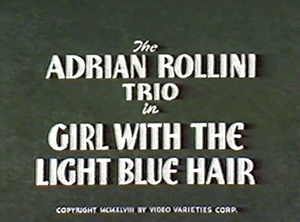
The first set of films produced by Video Varieties is a rather curious choice in terms of featured artist: The Adrian Rollini Trio. As much as jazz lovers enjoy, maybe revere, the music of Adrian Rollini, his “name recognition” in 1948 was extremely limited with the general public. But here he is, playing at least seven selections on vibes, piano, and tubular bells, supported by guitar and string bass.
Vince Giordano, himself a respected bass saxophonist, band leader and jazz historian recently noted,
“I met tuba / bass man Joe Tarto many times, and a few times we talked about Rollini. Joe told me they were good friends and were both working in Queens, NY at the World’s Fair [1939-1940]. Joe was playing with the City Service Band and Adrian was with his small group [playing vibes only]. They would meet for coffee on breaks and Joe told Adrian how great he was on the bass sax and that he really should keep on playing it. Adrian told him it was giving him headaches and that’s why he stopped playing it.”
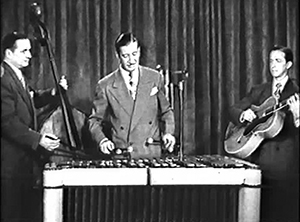
Most jazz fans would prefer Adrian working with the bass saxophone, an instrument on which he specialized during the 1920s and early 1930s. However, he had given up this instrument in the mid 1930s, and from that point on performed almost almost exclusively on the vibraphone. “My own thoughts: the music had changed and the bass sax, like in some ways, the tuba, was not used anymore in the swing era, save for Lombardo and a few sweet bands. And so the style Rollini played in might have been a little behind the times. Also: his new group was more hip, sophisticated and playing the vibes put him on the “front line” on the bandstand rather than being in the back pumping out bass lines.”
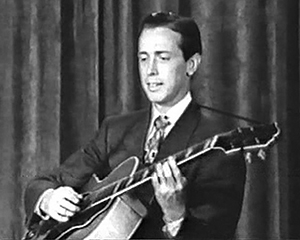
Supporting Rollini are two New York-based journeyman. Guitarist Allen Hanlon (Thomas Allen Hanlon, according to the the American Federation of Musicians Local 8O2 Directory) had played with many important jazz musicians, including Mildred Bailey, Red Norvo, and Claude Thornhill. Hanlon is a competent soloist, and he works in both the single note tradition of Charlie Christian, and the chordal approach of Carl Kress and Dick McDonough; at times he even uses a simplified picking style similar to that developed by Merle Travis.
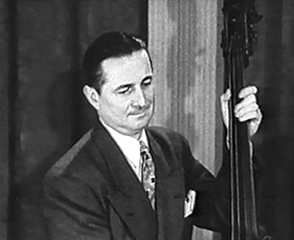
String bass player George Hnida had been associated with Rollini in 1936 and 1937, and returns to work with Adrian on this 1948 date.
While Hnida mostly provides rhythmic support, he is given some brief solo passages. He plays with precision and swing, if not a great deal of advanced technique or imagination.
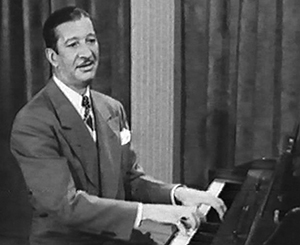
Rollini and his trio (with Fred Sharp on guitar) played at the Hotel Picadilly in New York the year before the films were made. The tight and well rehearsed arrangements might mean that the numbers were played often in public performance. (Rollini had recorded The Girl With the Light Blue Hair, in a very similar arrangement, in 1940.) However, the actual selection of tunes also suggests that many of the titles were selected because they were in the public domain, and therefore did not require royalty payments. The Adrian Rollini Trio titles include:
- Martha
- Dark Eyes
- Minuet in Jazz
- Girl With the Light Blue Hair
- Loch Lomond
- Blue Danube
- Minute Waltz
Enter United Artists
United Artists was a film production company formed in 1919 by D.W. Griffith, Charles Chaplin, Douglas Fairbanks, and Fairbank’s wife, Mary Pickford. Their intent was to control their “artistic destinies,” as opposed to working for one of the major studios. For many years United Artist released independent features made by filmmakers who needed a company with clout to publicize and release their product. UA released hundreds of films, produced by the likes of Walt Disney, Samuel Goldwyn, Hal Roach, David O. Selznick and others.
United Artists executives had kept a close eye on the development of television, and by early 1948 they realized that television could be an asset to their operations. Their earliest activities, that is 1948-49, included the reissue of a few United Artist features and short subjects, as well as the production of musical shorts. For the latter they turned to Video Varieties.
While it is not known who released the first series of films, that is, the Adrian Rollini shorts, United Artists was in the driver’s seat where the next two series were concerned. Strangely enough, rather than going with big name talent, or responding to “popular tastes” (a solo vocalist, or big band, for example), they selected a black vocal harmony quartet, The Striders, and a “city-billy” combo called Shorty Warren’s Western Rangers.
The entire United Artist package, that is, the feature films, short subjects and Video Varieties shorts, was announced in Boxoffice on April 9, 1949. The Adrian Rollini titles were not mentioned, and it is probable that they were produced and released before Video Varieties became associated with United Artists. While the April press notice cites the completion of production, there might have been some delay in release. All of the films in the series were copyrighted September 13, 1949. And while the films may have been released earlier — IMDB suggests dates in May 1949 — United Artists was far too sophisticated to allow material on the market without copyright in place, and it is more probable that the films were made available in September 1949.
We can assume that all of the films were made over a number of days in the New York City area, sometime in early 1949, perhaps February and March of that year. Prints were struck in both 35mm and 16mm.
The Striders
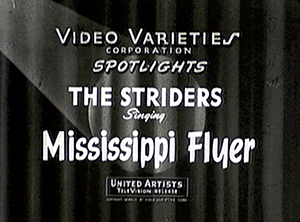
The Striders were one of the transitional groups reflecting the shift in the sounds of the 1940s to those of the 1950s, that is, from Mills Brothers-influence jazz to rhythm-and-blues and doo-wop. Their recordings were all made in (probably) less than five years, and all but five of their records find them as backup to female singers, most often Savannah Churchill.
The group was put together sometime before World War II by three brothers, Eugene, Charles and James Strider. Based in Columbus Ohio, they appeared in small nightclubs and, according to Charles Strider, “a lot of dumps.” A local photographer named Bob Rocke became their manager, and with Ernest Griffin added to the group, Rocke began booking the quartet in the Cleveland area.
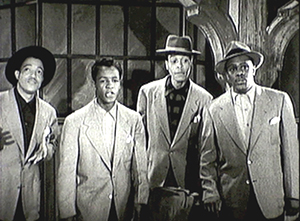
The combo was reformed after the end of the war, and with Rocke still providing the guidance, they moved to New York City where the Gale Agency began booking them. They finally landed a recording contract in 1948, and on July 17th the group recorded ten masters for Capitol Records; none was ever released. Two sides were released from a follow up session, October 1, 1948, although the record did not have strong sales.
January 1949 saw their first appearance on television, a Dumont series titled Hotel Broadway. The Striders played the bellhops, and performed on each program. The year was rounded out by further recording sessions and radio appearances. Sometime in the spring they appeared in the 13 films in this series. The titles are as follows:
- All Them Biscuits
- Bones, Bones, Bones
- Bottle of Wine
- Bye, Bye, Baby
- The Green Grass Grows All Around
- High, Wide and Low
- Make My Coffee Black
- Mississippi Flyer
- She Left Me For A Richer Man
- Unlucky At Gambling
- Vamoose
- Working On the Railroad
- Your Shirt Tale’s Out
My sincere thanks to Marv Goldberg for providing biographical information on The Striders liberally used above.
Shorty Warren’s Western Rangers
Virtually unknown today, Shorty Warren was a fixture in New Jersey in the later 1940s, earning himself the sobriquet “The Eastern King of Western Swing.” The group, Shorty Warren’s Western Rangers, worked regularly in the Newark area, premiering at the Club Argyle, which became Pecos City shortly thereafter. Both clubs were owned by one Maxie Frank, an important member of the painter’s union, who was probably fronting ownership and covering up silent “mob” involvement. By 1948 the group was being booked throughout the area, and they played an extended engagement at The Sequoia Club in Staten Island, New York. Sometime during the 1940s the band began broadcasting over WAAT, Newark.

A bit later Warren and group were featured at Shorty’s own establish- ment, The Copa Club, in Secacus, New Jersey. Around 1953, they had their own television show, The Garden State Barn Dance, which was broadcast over WATV in Newark every Sun- day. They recorded for any number of small record labels, including for Rita and Gametime Records.
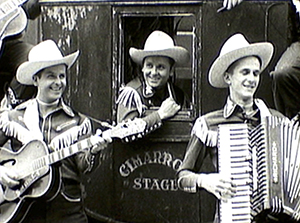
The Video Varieties titles by Shorty Warren and his Orchestra include:
- Come On Mule
- Don’t Bring Your Blues To Me
- Listen To the Mockingbird
- Lonesome Road Blues
- Raggedy Ann Hoe Down
- Red River Valley
- Yellow Rose of Texas
- You Told the World You Love
Note that an additional Shorty Warren musical piece titled Voters of Jersey City (sung to the tune of Glow Worm), has circulated among collectors. This is a curious piece, in support of one Johnny Denny. The last name is not clear in the song, but we do know that Johnny was for “labor and the small guy.” This film was probably made for television, and is not a part of the Video Varieties series.
There were actually two sideline sessions (that is, filming to playback) for the Shorty Warren series. The first appears to be on a soundstage, probably West Coast Service Studios, where the group performs along with a sextet of square dancers. The second is an exterior set picturing a traditional town of the “Old West.” This allows for the use of more sideline extras, and provides a much more authentic “look” to the film.
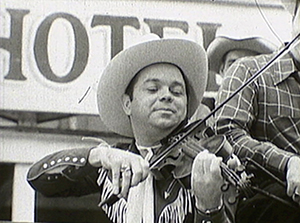
The personnel of the Western Rangers is somewhat uncertain, although we know that Shorty Warren is seen and heard on string bass; his brother, Smokey is on guitar. The second guitar player is probably Coy McDabiel (real name Leland West). On accordion we probably see and hear Dick Richards, although this is his nom-de-performance, his real name not known. Cy Shwed is the fiddle player in the band.
The Music: An Evaluation
This is a curious series in the history of music on film, and it is certainly little more than a footnote in our ongoing study of jazz on film. The series filled a need at the time, although it would be Snader Telescriptions, first produced in 1950, that would totally expand upon and effectively exploit the concept of musical shorts for television.
For jazz fans, the most important session is clearly the one featuring Adrian Rollini. The music swings, and Adrian is a fine vibes soloist, even if he is not at the same level as Red Norvo or Lionel Hampton. (And it is wonderful to also see him perform on piano and bells.) Allen Hanlon is a more than competent guitarist. As noted above, his playing reflects a number of different approaches to the instrument. This is relaxed supper club / chamber jazz, and since recordings by Rollini from the late 1940s are limited (his 1949-50 session for Mercury is apparently not available on CD), these films provide a fascinating look at Adrian Rollini toward the end of his career. Rollini died in 1956, apparently from mercury poisoning, and these are some of the last sounds that he recorded in a way too brief life.
Of the thirteen shorts featuring The Striders, I have only two, and making any type of judgment based on incomplete evidence is a questionable practice at best. The Striders, performing acapella, bring to mind the Mills Brothers, among others, although they also look forward to the doo-wop combos of the 1950s. They are obviously well-rehearsed, and are able to swing effortlessly, without any instrumental support. The Green Grass Grows All Around is a workout on a popular, if insipid, song for children. While I cannot see the attraction of this piece, remember that Louis Jordan and Josh White also recorded the composition. Mississippi Flyer, on the other hand, is a gospel piece swung in an easy style that reflects not only earlier vocal harmony groups (in this case the Delta Rhythm Boys come to mind), but also the sounds of the decade to come.
Shorty Warren’s group is the hardest to place stylistically. Most of the press notices cite him as “Eastern King of Western Swing.” However, only two of the films contain music that bears any resemblance to that of Bob Wills, Milton Brown or the Spade Cooley. The other numbers range from country hoedowns to ballads to novelties. The Yellow Rose of Texas and Lonesome Road Blues are the most satisfying of the set, coming closest to the Western Swing billing. None of the solos is particularly compelling, although there is nothing here that would offend any listener interested in popular music sounds of the the 1940s, especially the urban country music known as “city-billy.”
Why Video Varieties ceased operation after three sessions is unknown, unreported in the press and lost to time. Had they continued production for one year, continuing to film talented but little-known artists, imagine their surprise when Lou Snader would begin to issue similar music shorts with the likes of Duke Ellington, Count Basie, Nat “King” Cole, Cab Calloway, Bob Crosby, Peggy Lee, George Shearing and many others. Perhaps it was best to quit while they were ahead! In any case, among the twenty-eight titles are some gems, and like so many other minor concerns, the Video Varieties shorts illuminate yet another small corner of our music’s history.
I would like to thank Ate van Delden, Kevin Coffey and Marv Goldstein for their support and input for this article. Be sure to check out Marv’s wonderful website at: uncamarvy.com
A sample of films from each of the three sessions can be found on my website, here.
